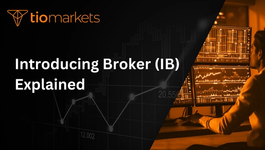Dotcom bubble: Explained | TIOmarkets
BY TIOmarkets
|July 5, 2024The Dotcom bubble, also known as the Internet bubble, was a historic economic event that occurred from 1995 to 2001. It was characterized by a rapid rise and subsequent fall in technology stock prices fueled by the growth and adoption of the Internet and speculation around its potential. This period saw a surge in equity investments in internet-based companies (dotcoms) leading to inflated market valuations and a subsequent market crash.
Understanding the Dotcom bubble is crucial for traders as it provides valuable insights into market dynamics, investor psychology, and the potential risks associated with speculative bubbles. This glossary entry aims to provide a comprehensive understanding of the Dotcom bubble, its causes, effects, and its significance in the context of trading.
Origins of the Dotcom Bubble
The origins of the Dotcom bubble can be traced back to the early 1990s when the Internet was becoming mainstream. The advent of the World Wide Web opened up a world of possibilities for businesses and consumers alike. Companies began to realize the potential of the Internet as a platform for business, leading to the birth of dotcom companies.
Investors, seeing the potential for massive growth, began pouring money into these companies. This led to an initial surge in stock prices, which further attracted more investors. The result was a positive feedback loop, where rising stock prices attracted more investment, leading to further increases in stock prices.
Role of Venture Capital
Venture capital played a significant role in the formation of the Dotcom bubble. Venture capitalists, attracted by the potential for high returns, invested heavily in dotcom startups. These investments often resulted in high initial public offering (IPO) valuations for these companies, further fueling the speculative bubble.
However, many of these companies were not profitable and had no clear path to profitability. Despite this, investors continued to pour money into these companies, believing that future profits would justify the high valuations.
Role of the Media
The media also played a significant role in the formation of the Dotcom bubble. Stories of instant wealth and the transformative potential of the Internet fueled investor enthusiasm. This led to a "fear of missing out" among investors, further driving up stock prices.
However, the media often failed to critically analyze the business models of these companies. This lack of scrutiny contributed to the overvaluation of these companies and the eventual bursting of the bubble.
Peak and Burst of the Dotcom Bubble
The Dotcom bubble reached its peak in March 2000. By this time, many dotcom companies had seen their stock prices increase exponentially. However, the bubble began to burst when it became clear that many of these companies were not able to deliver on their promises of profitability.
As investors began to lose confidence, stock prices started to fall. This led to a panic sell-off, further driving down stock prices. By the end of 2001, most dotcom companies had gone bankrupt, and investors had lost billions of dollars.
Impact on the Economy
The bursting of the Dotcom bubble had a significant impact on the economy. The rapid decline in stock prices led to a loss of wealth for investors. This resulted in a decrease in consumer spending, which in turn led to a slowdown in economic growth.
Furthermore, the collapse of the bubble led to a significant increase in unemployment. Many dotcom companies, unable to sustain their operations, were forced to lay off employees. This further exacerbated the economic downturn.
Lessons for Traders
The Dotcom bubble provides several important lessons for traders. First, it highlights the dangers of speculative bubbles. Traders must be cautious of situations where asset prices are driven up by investor enthusiasm rather than underlying fundamentals.
Second, it underscores the importance of critical analysis. Traders must not rely solely on media hype or the promise of future profits. Instead, they should carefully analyze a company's business model and financial health before investing.
Aftermath of the Dotcom Bubble
The aftermath of the Dotcom bubble was characterized by a period of economic downturn, known as the "dotcom recession." However, it also led to a period of consolidation and restructuring in the tech industry.
Many surviving dotcom companies were forced to rethink their business models. This led to a focus on profitability and sustainable growth, rather than just user acquisition and market share. As a result, many of these companies emerged stronger and more resilient.
Survivors of the Dotcom Bubble
Despite the widespread destruction, some dotcom companies managed to survive the bubble. These companies, including Amazon and eBay, were able to adapt their business models and achieve profitability. Today, they are among the most successful and influential companies in the world.
The success of these companies serves as a reminder that even in the midst of a bubble, there are opportunities for savvy investors. However, it also underscores the importance of careful analysis and prudent investment decisions.
Regulatory Changes
The Dotcom bubble also led to changes in regulatory policies. In the wake of the bubble, regulators took steps to improve transparency and accountability in the financial markets. This included stricter reporting requirements for publicly traded companies and increased oversight of investment practices.
These changes were designed to protect investors and prevent the formation of future bubbles. However, they also increased the complexity and cost of compliance for companies, potentially impacting their profitability and growth.
Dotcom Bubble and Modern Trading
The Dotcom bubble has had a lasting impact on trading. It has shaped investor attitudes towards tech stocks and has influenced trading strategies and regulations. Understanding the Dotcom bubble is therefore crucial for modern traders.
Moreover, the Dotcom bubble serves as a cautionary tale for traders. It reminds traders of the dangers of speculative bubbles and the importance of careful analysis and prudent investment decisions.
Impact on Trading Strategies
The Dotcom bubble has influenced trading strategies in several ways. First, it has made traders more cautious of tech stocks, particularly those of internet-based companies. Traders are now more likely to scrutinize the business models and financial health of these companies before investing.
Second, it has highlighted the importance of diversification. The Dotcom bubble showed that investing heavily in a single sector can be risky. As a result, traders are now more likely to diversify their portfolios to spread risk.
Impact on Trading Regulations
The Dotcom bubble has also influenced trading regulations. In the wake of the bubble, regulators have implemented stricter reporting requirements and increased oversight of investment practices. These changes have increased the transparency and accountability of the financial markets, making it safer for traders.
However, these changes have also increased the complexity and cost of compliance for companies. This has potentially impacted the profitability and growth of these companies, which in turn can affect their stock prices and the returns for traders.
Conclusion
The Dotcom bubble was a significant event in the history of trading. It provides valuable lessons for traders about the dangers of speculative bubbles and the importance of careful analysis and prudent investment decisions. By understanding the Dotcom bubble, traders can better navigate the complexities of the modern trading environment.
While the Dotcom bubble was a period of extreme volatility and loss, it also led to important changes in the tech industry and the financial markets. These changes have shaped the way we trade today and will continue to influence trading strategies and regulations in the future.
Start Trading with Confidence at TIOmarkets
Don't let the lessons of the Dotcom bubble pass you by. Join TIOmarkets, a top-rated forex broker, and leverage our comprehensive suite of educational resources to trade with insight and strategy. With over 170,000 accounts opened across more than 170 countries, our platform offers you the opportunity to trade over 300 instruments across 5 markets with low fees. Ready to apply the historical insights to modern trading? Create a Trading Account today and navigate the markets with confidence.

Risk disclaimer: CFDs are complex instruments and come with a high risk of losing money rapidly due to leverage. You should consider whether you understand how CFDs work and whether you can afford to take the high risk of losing your money. Never deposit more than you are prepared to lose. Professional client’s losses can exceed their deposit. Please see our risk warning policy and seek independent professional advice if you do not fully understand. This information is not directed or intended for distribution to or use by residents of certain countries/jurisdictions including, but not limited to, USA & OFAC. The Company holds the right to alter the aforementioned list of countries at its own discretion.
Join us on social media

Behind every blog post lies the combined experience of the people working at TIOmarkets. We are a team of dedicated industry professionals and financial markets enthusiasts committed to providing you with trading education and financial markets commentary. Our goal is to help empower you with the knowledge you need to trade in the markets effectively.





